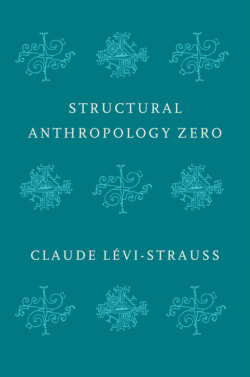Читать книгу Structural Anthropology Zero - Claude Lévi Strauss, Claude Levi-Strauss - Страница 7
Introduction by Vincent Debaene
Оглавление“Your thought is not yet mature.” According to Claude Lévi-Strauss, this is how Brice Parain, then assistant and editorial advisor to the illustrious publisher Gaston Gallimard, explained his decision not to publish the collection of articles entitled Structural Anthropology. In his account Lévi-Strauss does not date the incident but indicates that it took place “before writing Tristes Tropiques” – i.e. likely sometime in 1953 or 1954.1 Beyond his stated motive, Parain – whom Lévi-Strauss would soon describe as among the “opponents of anthropology”2 – probably did not think very highly of volumes of collected articles in general, often seen as too heterogeneous and repetitive to make for a good read. However, the manuscript of Structural Anthropology that Lévi-Strauss submitted to the Plon publishing house – which was ultimately published in 1958, three years after Tristes Tropiques – was not simply a compilation of previously published work preceded by a perfunctory preface. Quite the contrary, the collection had a robust structure, dispensing with a lazy chronology in favor of a thematic organization in five parts and seventeen chapters. The volume proceeds from the most fundamental level at which social facts are structured (“Language and Kinship”) to “Social Organization” and then to the concrete expressions of these underlying structures, which can be traced in rites and myths (“Magic and Religion”), before turning to creative expression (“Art”) and finally to the question of the place of anthropology in both the field of social science and modern education (“Problems of Method and Teaching”). The whole is preceded by an ambitious introduction that outlines the respective roles of anthropology and history, at a time when the latter was emerging as one of the most high-profile and innovative disciplines in the social sciences, as demonstrated by the prominent place it was given within the newly founded “Sixth Section” of the École Pratique des Hautes Études, ancestor of today’s École des Hautes Études en Sciences Sociales (Lévi-Strauss himself was a member of the “Fifth Section,” devoted to the “Religious Studies”).
In retrospect, it seems clear that the publication of Structural Anthropology marked a crucial stage in the rise and spread of structuralism. The carefully conceived organization of the book undoubtedly played an essential role in this. It highlighted the extremely innovative character of the thought as well as the theoretical ambition of a body of work that relied on very precise anthropological data even while opening up onto other disciplines (linguistics, history, psychoanalysis, etc.) and the anglophone literature in the field. It thus lent the work a certain force, further enhanced by its programmatic title. It should be recalled that this was by no means a sure bet. Against the sense of inexorability conveyed by retrospective accounts, which lay out a chronology of editorial and institutional successes, it is important to remember that the adjective “structural” was considered at the time to be something of a vulgarism and that the entire enterprise was a bit of a gamble. After all, intellectual history is strewn with stillborn neologisms, conceived in the heat of the moment as banners and manifestos.
Structural Anthropology was thus both more than and altogether different from collections of contributions artificially bound together by a title. This is also true of Structural Anthropology, Volume II, which came out in 1973 and whose organization is rather similar to that of the first volume: the “Perspective Views” that explore the history and pre-history of modern anthropology are followed by two sections, entitled “Social Organization” and “Mythology and Ritual,” closing with a final (and long) section entitled “Humanism and the Humanities.” Here again, the order reflected stages of thought, with chronology playing no part. The book even concludes with the essay “Race and History,” which had been first published twenty years earlier, in 1952; however innovative it might have been (and still is), this short treatise on cultural diversity and evolutionism had not found its rightful place within the architecture of the first volume – more affirmative and more disciplinary, less concerned with locating anthropology within a set of reflections that made the destiny of humanity its object – while it provided an ideal complement to meditations on the notions of humanism and progress.
Although its structure differed from that of the two previous volumes, The View from Afar – published in 1983 and which Lévi-Strauss would have gladly entitled Structural Anthropology, Volume III, had the adjective not by then become trite and “lost its content” due to its status as an intellectual “fashion”3 – obeyed the same principle. Less strictly anthropological, the book engages more directly with the theories and ideologies of its time, through a discussion of the various forms of constraint that weigh on human activity.
In any case, two conclusions may be drawn. First, the Structural Anthropology volumes were indeed conceived as books – i.e. as theoretical interventions into debates that they sought to shape and not as simple collections of essays. Second, the way Lévi-Strauss understood anthropology, its methods and objects, did not evolve much over the course of his career. The only true exception is probably with regard to the status of the distinction between nature and culture: initially presented (in The Elementary Structures of Kinship, in 1949) as an anthropological invariant, in line with social science since its origins in the eighteenth century, it became a distinction of “primarily methodological importance,” according to his formulation in The Savage Mind in 1962.4 With the exception of this shift, in keeping with his redefinition of the concept of symbol,5 Lévi-Strauss’s thought remained very faithful to a few governing principles, and its evolution has to do more with the diversity of objects to which it was applied than with any change in the “rustic convictions” (to quote Tristes Tropiques) that guided his project.
